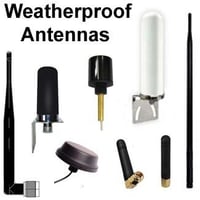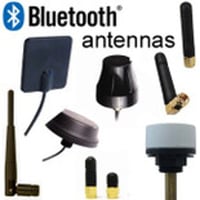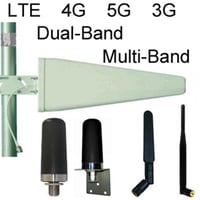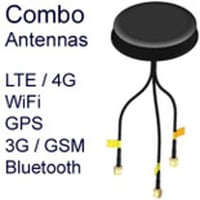Mounts for Antennas w/ N-female
Mounts for Antennas & Cables with Type-N female connectors:
Mounting options for the N-Type female connector antenna
The stability and weather resilience of the N connector makes it a connector of choice for outdoor (an also attic) antenna installations. There are several options for appropriately mounting an N connector antenna that accommodate the antenna type and location. N female connector mounts usually have a hole for the connector that perfectly accommodates the female N connector. This means that the antenna can be securely connected to N connector antenna cable which can be further secured if a bulkhead N connector is used.
N female to N female bulkhead connectors are in-series N connector adapters with a straight body (1.49 inches / 38 millimeters end-to-end) and in-line orientation. They sit within the hole of the antenna mount and are secured at either end with the antenna and a complementary antenna cable. They are typically fabricated from nickel-plated brass and have a 50 Ohm impedance with similar frequency ranges to the standard N-type connector.
Key types of antenna bracketry available for use with a female N-type connector antenna cable.
[A] L mounts are heavy-duty, right-angled bracket named after their “L” shape. L mount antenna brackets provide easy, elevated, offset mounting and are a good choice for low profile outdoor antennas. They are typically made from stainless steel or other strong metal alloys that can withstand outdoor exposure.
An N female connector L-mount mount works with male N connector antennas. Their shape and orientation allow these metal mounts to hold an N connector antenna upright while being secured to a wall. The antennas position within the mount can be changed by rotation. They have holes for attaching the mount to a wall on one side and an opening for the N connector on the other side. A bulkhead mount or end-to-end N connector can sit within the L-mount that allows the connection of both the antenna and its cable at a single point. They can also be adapted for attachment to poles using U-bolts if needed for placement of the antenna at maximum height.
[B] U-Bolts are a common type of antenna mount that consists of at least two “U-shaped” threaded bolts and sets of paired hex nuts. They require support or another mount to work. They are an inexpensive and easy to install solution for mounting an N-connector antenna to a pole securely. They are advantageous for achieving great elevation or mounting omnidirectional antennas like collinear array antennas. The pole or masts sits within the U-bolts and the U-bolts can be connected to an antenna bracket for mounting the antenna. The hex nuts supplied tighten down on the thread of the bolt behind the support to increase the grip on the pole. U-bolts work with L-shaped mounts and J-mounts. If they are angled they are known as V-bolts.
[C] Articulating mounts can be used with both masts (via U-bolts) and direct wall mounting. They are an adjustable mounting solution that delivers a mounting platform that is strong and secure while providing the ability to more precisely adjust the antenna. N connector versions have a precisely-sized hole to accommodate the N connector. Horizontal or vertical adjustable mounting positions are useful for matching antenna polarization or improving coverage in a specific area or applications like RFID.
Other mounting arrangements for N connector antennas include
[D] Side mounts facilitate robust mounting of an antenna on the side of vertical surfaces. It is often used as a space-saving solution. They are ideal for long term antenna mounting on the side of a house or RV.
[E] Mast and pipe clamps are useful for mounting base station antennas as they can be used to gain additional height via attachment to:
- Angle rods
- Pipes
- Flat surfaces
- Wooden poles
[F] Roof mounting kits can be used with L-mounts and U-bolts to securely position an N connector antenna at the highest point of a building. They are either base mounts or tripod mounts that consist of a tripod or pyramidal frame supporting a central mast to which the U-bolts and L-mount for the antenna can be attached. Tripod mounts are more robust and resilient against high winds and should not require additional guy wires if the mast is under 3 feet (91 centimeters) in height. Some roof mounting kits are adjustable to accommodate the pitch of the roof. Some of these brackets can be adapted for attic installation if the suspension of the antenna via mast is required.
Improve Antenna Performance with Mounts
Antenna mounting is critical to the performance of any antenna and must be executed correctly if the antenna is to be expected to function optimally in its intended application. Poor installation techniques and hardware will lead to the deleterious performance of the antenna. The antenna may not be securely positioned and can become at risk of being displaced or a safety hazard. A suitably matched and well-installed mount should support antenna performance and also contributes to the longevity of the installation which can last several decades if done properly.
Considerations for positioning an antenna for installation
The location of your antenna will determine the safety and performance of the installation. A priority is maximizing the line of sight visibility of the antenna so that it has the optimum range for transmitting or receiving signals successfully. This is best achieved by mounting your outdoor N connector antenna as high as is feasible which should keep it clear from obstructions like vegetation and trees and bodies of water that can cause signal reflections and interference.
Depending on the type of N connector antenna used, you may need to make arrangements of grounding the antenna for it to perform properly. Collinear antennas and monopole antennas need a ground plane or good earthing system to function optimally.
Your installed antenna may also require minor adjustment to accommodate its polarization and matching by using VSWR measurement to ensure that the characteristic impedances within the antenna system are properly aligned.
Key mounting techniques of mounts for antennas with an N female connector
- Mounting antennas to walls: Antennas can we wall mounted with suitable brackets, taking care that the antenna remains clear of any overhang of the roof or guttering. Using multiple brackets and spacing the antenna mounts will increase the strength of your installation. Depending on the size of the antenna or pole to be wall mounted the brackets should be separated by at least 2 feet (60 centimeters). Methods used to secure your L-mount or another bracket to the wall securely include use of wall anchors, masonry plugs, sleeve anchors or shield anchors which can provide the necessary hold on the brickwork. Always screw your mounts into the brick and not the mortar.
- Mounting antennas to roofs: You can use wither a base mount or tripod to hold the antenna mast. These will need to be securely fixed to the roof. Tile and slate mounts are a non-penetrative alternative form of roof mount that does not penetrate the tile but rely on weight, sitting on cleats that are inserted under the roof tiles. A steel mast can be inserted for attachment of the antenna. The mast should also be secured to the roof using guy wires.
- Mounting antennas to chimneys: This requires care as a tall mast in high winds can break off a deteriorating chimney. Ensure that the chimney is in good condition, able to weight bear and if the chimney is in active use mount the antenna at a suitable height to clear smoke and gases that will impair its performance. The mounting height should not exceed 10 feet (3 meters) Aside from the mounting the antenna pole will need to be suitably guyed and lashed to the chimney.
Safety is critical when installing your N connector antenna
Competent installation of an antenna can be difficult if you are inexperienced, so if you are in any doubt of your ability to safely install an antenna it is always best to arrange mounting by a professional installer.
Antenna installations carry not only the risks of working at height but also a risk of electrocution. Electricity from lightning or a contacted powerline will rake the shortest route to earth and you do not want to be part of it! Therefore you must remain aware of your safety at all times while completing your install.
- Do not attempt antenna installation or rectification of mounting issues on wet, windy or stormy days.
- Never install an antenna near overhead powerlines. Powerlines can be mistaken for guy wires or telephone lines, therefore it is best to exercise caution with all overhead lines.
- When mounting your antenna, wear rubber-soled shoes and gloves. Long-sleeved clothing is advisable.
- Do not use a metal ladder.
- It may also be worthwhile calling your local power company and getting advice on your plans if you are concerned about proximity to a powerline.
- If any part of your antenna or mounting equipment doe contact and overhead powerline do not touch or move it and call the power company, explaining the situation.
Frequently asked questions:
Can a female N connector bracket used with other types of antenna?
The selection of brackets available can also be used with other antennas or for other purposes. If you intend to mount an antenna with a smaller connector diameter, the mount can be used with an N connector adapter for the antenna connector to mate with the N female bulkhead, or insertion of a washer or metal plate with an opening of a more appropriate size.
Galvanization is Key for Long-Term Weather Protection
Hot-dipped galvanized brackets will not rust and usually have greater longevity than ungalvanized ones. Though rust on your mount is unlikely to compromise the integrity of the antenna installation, it may produce unsightly stains on your walls or roofing if water tracks down through it. Rusting and structural deterioration of mounts may be accelerated in coastal conditions due to the moist salt air.
Do I need to use guy ropes?
Guy wires or guy lines are tensioned wires that you can use to increase the stability of your mast or pole-mounted antenna installation, especially in high winds which can easily break of a pole of several feet in height. Guy ropes need to be carefully installed and tensioned and should not come into contact with any of the antenna elements. A basic install of four wires has them extend from the mast at a 45-degree angle, with anchoring via firmly-anchored screw eyes spaced at 90-degree intervals. They can also be used as lashing wires for chimney antenna installations.
Do I need surge protection for my antenna installation?
Lightning arrestors also known as surge protectors will protect downstream radio equipment like signal boosters or devices from lightning striking your external antenna. A surge protector will either absorb or divert to ground the excess voltage generated, so protecting your equipment. They are installed as part of the antenna circuit and N-type surge protectors can be readily installed in-line via its N-male to N-female or N-female to N-female integrated connectors with 50 Ohm impedance and frequency handling up to 6 GHz.
How can I weatherproof my antenna installation?
Taking some basic steps to minimize moisture ingress into your assembly will prolong the life of your mounted antenna and cabling. Corrosion, once started, progresses quickly so it is important to minimize the risk of this happening to your electronics. Coaxial cable weather sealant tape can be used to protect connectors. Simply wrap the stretchy self-adhesive tape around the connectors and it will shrink to size forming a waterproof seal. Roofs can also be protected by placement of a non-slip mat beneath the mount or use of roof sealant tape.
Organizing your cabling also help avoid moisture tracking into your electronics. Keep your cable tidy and secured and incorporate a drip loop (that diverts the water to the ground, rather than along the line) if it is excessively long.
About Type-N Connectors for Antennas
N-type connectors:
The N connector is a medium-sized thread-coupling radio frequency connector which is the key feature of these antennas. Designed in the 1940s by Bell Laboratories, it was one of the first radio frequency connectors capable of handling microwave frequencies, in particular, those above 1 GHz. Contemporary versions of the N-type or Navy connector are now capable of supporting frequencies up to 11 GHz. N connectors are typically made from nickel-plated brass, with beryllium copper conductors surrounded by an air or PTFE dielectric. They are available in 50 and 75 Ohm versions that are structurally incompatible. The N-type connector is favored for its ruggedness, easy handling and consistent performance with low signal loss. Many of the Female N connector antenna mounting options shared on this page will form a secure mated connection with the male N connector on the antenna, with a male inner pin being inserted into the receptacle on the female N connector as the male screws down onto the female. You can connect and disconnect your antenna from its mounting with confidence as, with proper use, the N-female connector is rated for over 500 mating cycles.
Mounts for female N connector antennas are mounts that are either specifically designed for, or compatible with an N female connector. The female N connector can make a secure connection to a male N connector antenna while being secured by the antenna mount. They are used to facilitate the precise installation of antennas in a variety of indoor and outdoor settings, mounting to walls or on poles and support the applications for which the antenna is used. In some cases, the antenna mount also serves as a ground plane for the antenna. Female N connector antenna mounting hardware can help you achieved the height and positioning needed to assist your N connector antenna in achieving optimal coverage and connectivity.
High quality, secure mounting arrangements are the perfect match for rugged N connector antennas and brackets and mounts that accommodate the N female bulkhead adapter make connecting the antenna and cabling simple. If installed properly the mounted antenna should deliver a long service life. Care must always be taken when installing and removing antennas, due to work at height and the risks of electricity.
N connector antennas:
N connector antennas are a diverse group of antennas which all have the key feature of an N connector as the primary point of mechanical and electrical connection of the antenna to cabling and/or up/downstream radio frequency devices. They are ideal for outdoor use due to the weatherproof and rugged qualities of the N connector and are commonly used for Wireless Local Area Networking (WiFi and other WLANs), cellular communication, Amateur Radio and GPS. You can learn more about male N connector antennas and browse a selection of high-quality versions here. You can readily mount N-type connector antennas in the antenna mounting solutions shared above.
LEARN MORE:







